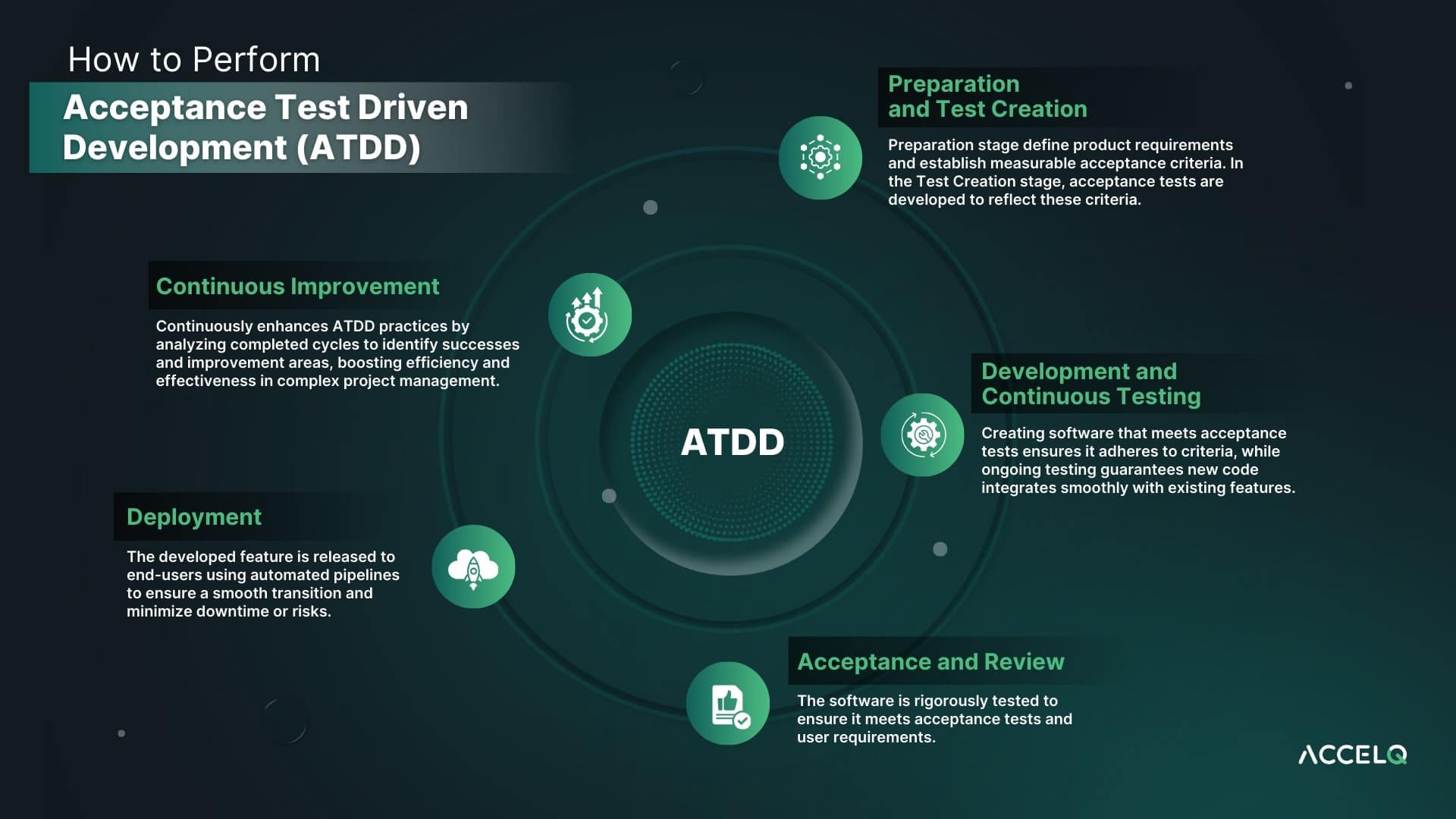Acceptance Test Driven Development: A Comprehensive Guide

Understanding the user perspective of any application is critical. Even getting it before the coding indulgence is the perfect methodology. ATDD not only clarifies expectations but also enhances product quality by aligning it with business goals and user needs. It facilitates a development environment that brings collaboration between teams for customer satisfaction.
What is ATDD
Acceptance Test Driven Development prioritizes the end user’s needs by making acceptance tests a development foundation. In this methodology, the functionality developed aligns with the main objectives. The acceptance tests are written from the user’s perspective and created before coding begins.
While ATDD shares similarities with BDD to focus on system behavior, it focuses on the precise user requirements. A typical ATDD workflow would define the acceptance criteria using Gherkin syntax (Given, When, Then). This enables the entire team, including business analysts and developers, to understand the testing scenario before implementation. It is a proactive process that avoids wasted efforts and ensures the development meets the initial business goals.
Why Perform ATDD
Collaboration between customers, developers, and testers is one of the more significant key factors to consider. Of course, collaboration is the main objective for clear communication and understanding of goals.
Key factors for adopting ATDD:
- Enhanced Quality Assurance: Establishing acceptance criteria upfront and creating automated tests to verify them ensures software meets stringent quality standards.
- Early Problem Detection: Tests begin before the code providing provident feedback to developers on code requirements. The early detection enables quicker adjustments reducing time and cost investment.
- Reduced Rework: Early detection and speeding up the process minimizes the need for revisions.
Components of ATDD
ATDD is versatile and can be integrated across various software development methodologies, including Agile, waterfall, and hybrid approaches.
Testing Frameworks
ATDD relies on automated tests for verifying the acceptance criteria using popular frameworks such as cucumber, test automation framework, and many more for writing test cases.
Collaboration Tools
Collaboration between your Jira, Trello, Asana, and other tools is essential for the best results. It enhances communication and progress tracking between developers, testers, and customers.
Version Control Systems
Systems like Git and SVN are crucial for managing changes in the codebase, allowing for efficient coordination among team members.
Mocking and Stubbing Frameworks
Before the coding begins, acceptance tests are crafted using mocking frameworks like Mockito and EasyMock to create fake objects and stubs to simulate dependencies.
How to Perform ATDD
ATDD integrates acceptance testing into the software development lifecycle to ensure all developed features meet the stakeholder’s predefined criteria.
Preparation and Test Creation
The ATDD cycle begins with a Preparation stage, during which the development team, product owners, and stakeholders define the product requirements. This collaborative phase involves crafting specific, measurable, and testable acceptance criteria based on the user’s needs.
Following this, acceptance tests are formulated during the Test Creation stage to mirror these criteria. These tests, designed from the user’s perspective, focus on the system’s desired behavior under various conditions, setting the stage for development focused on fulfilling user needs.
Development and Continuous Testing
With acceptance tests in place, the Development stage focuses on creating software that passes these tests, indicating that the software adheres to the criteria. Developers work iteratively, continuously running tests to validate functionality and make necessary adjustments.
Concurrently, ongoing Testing ensures that new code integrates seamlessly with existing features, maintaining functionality and catching issues early to mitigate later costs.
Acceptance and Review
The software undergoes rigorous testing in the Acceptance stage to confirm it passes all acceptance tests. This stage includes a critical review by stakeholders to ensure the software not only passes the tests but also satisfies practical user requirements. Following this, the Review and Adaptation phase allows the team to reflect on the development process, acknowledging successes and identifying areas for improvement to enhance future ATDD cycles.
Deployment
Once the software has successfully passed the acceptance and review phases, it moves to Deployment. This stage involves releasing the developed feature into production and making it available to end-users. Effective deployment typically utilizes automated pipelines to ensure a smooth transition and minimize potential downtime or risks.
Continuous Improvement
After deployment, the team engages in a continuous improvement process to refine their ATDD practices. This involves analyzing the completed cycle to identify what worked well and could be improved, ensuring that each cycle enhances the team’s efficiency and effectiveness in handling complex projects.
ATDD vs TDD
| Aspect | TDD | ATDD |
|---|---|---|
| Focus | Concentrates on implementing small units of functionality via unit tests | Focuses on fulfilling user acceptance and system-wide requirements |
| Test Scope | Primarily unit tests written by developers | Acceptance tests that cover user scenarios, written collaboratively |
| Primary Benefit | Enhances the design and ensures the code works as intended | Ensures the product meets business requirements and user needs |
| Stakeholder Involvement | Mainly developers | Includes customers, QA teams, and developers for broader collaboration |
| Language of Tests | Often in the same programming language as the code (e.g., Java, Python) | Usually in simple English, using Gherkin to specify scenarios |
Benefits of ATDD
Acceptance Test-Driven Development (ATDD) extends the principles of Test-Driven Development (TDD) by incorporating acceptance tests, which offer unique advantages.
- Enhanced Quality Assurance: ATDD ensures that software development aligns with user expectations, delivering high-quality features that meet the precise needs of end users.
- Improved Collaboration: Its ability to establish collaboration between technical and nontechnical teams ensures faster communication and requirement understanding.
- Regression Suite: A comprehensive suite of acceptance tests helps detect regressions in the code that can affect existing functionalities. Upon addressing them, ensure everything is performing as required.
- Streamlined Development Process: It is a guiding framework for the entire development cycle, making it easy to manage and navigate.
Example of ATDD
A financial software team utilized ATDD to develop a new credit card payment system. Working with creditors and banking professionals, they defined acceptance criteria, including entering applicant information, calculating outstanding payments, and approving or rejecting transactions based on available balances. Automated acceptance tests were then developed to ensure these functionalities were accurately implemented.
Challenges of ATDD
While ATDD offers numerous advantages, it also presents challenges:
- Time and Maintenance: Developing and updating acceptance tests can be time-consuming, and as the codebase evolves, maintaining current tests becomes increasingly complex.
- Technical Skill Requirements: Writing and maintaining acceptance tests demands a certain level of technical skill, which may be a barrier for team members with limited coding experience.
- Infallibility: Although acceptance tests can detect many flaws early, they are not foolproof, and bugs can still slip through, particularly if not all scenarios are covered.
- Team Dynamics: Effective ATDD implementation requires strong coordination and communication skills among all stakeholders, which can be challenging for teams lacking these skills.
Conclusion
By adopting ATDD in the development cycle, teams can reduce misunderstandings, increase efficiency, and improve product quality. For thos looking to implement ATDD in their projects, ACCELQ can simplify the creation, management, and execution of acceptance tests. Connect with our team for a proper demo to learn how we can help you with successful outputs and growth.
Suma Ganji
Senior Content Writer
Expertly navigating technical and UX writing, she crafts captivating content that hits the mark every time. With a keen SEO understanding, her work consistently resonates with readers while securing prime online visibility. When the day's work ends, you'll find her immersed in literary escapades in her quaint book house.
You Might Also Like:
 Non-Functional Testing: Types, Examples & Why It Matters?
Non-Functional Testing: Types, Examples & Why It Matters?
Non-Functional Testing: Types, Examples & Why It Matters?
 The Importance of Accessibility Testing for Enterprises
The Importance of Accessibility Testing for Enterprises
The Importance of Accessibility Testing for Enterprises
 Performance Testing Guide: Everything You Must Know in 2026
Performance Testing Guide: Everything You Must Know in 2026




































